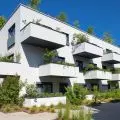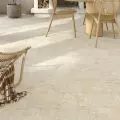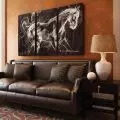If you were in Gdańsk last weekend (November 17-18), you might have noticed crowds of people armed with thermoses and warm jackets boarding buses heading towards Orunia in the evening near the Central Station and the Upland Gate. Why such a stir? Well, for the 14th time the NARRACJE contemporary art festival was taking place. This year the organizers chose the Orunia district as the place for artistic interventions, and the slogan of the whole event was "Soft Spots."
The NARRACJE festival is organized by the Institute of Urban Culture in cooperation with the Gdańsk City Gallery. Every year, the art works presented in public space become a navigator of urban adventure, so to speak, an artistic journey, encouraging exploration of the chosen district. NARRACJE is always held in November and always in a different neighborhood, which becomes a point of reference and inspiration for artists.
The curators of this year's NARRACJE were Katarzyna Słoboda and Jakub Gawkowski
photo: Michal Szymończyk, IKM
The curators of the 14th edition, which was covered by Architektura & Biznes as a media patron, were Katarzyna Słoboda and Jakub Gawkowski, who carried out their concept under the slogan "Soft Spots."
Soft spots are places that require attention. The kind that, when looked at closely and given time, reveal their energy and multi-layered stories. Our concept for the NARRACJE festival is to find existing and create new tender points on the map of Gdańsk Orunia. They will designate spaces and routes for moving together and establishing relationships with art, people and the environment itself," explained the premise of this year's edition.
audience of the NARRACJE festival
photo: Michal Szymończyk, IKM
Orunia, and where is it?
Orunia, as we read on the festival's website, located between the moraine hills and fertile polders of Gdańsk's Żuławy, has been a district of Gdańsk since 1933, but its history dates back to the early days of the city. It was a rich village on an important merchant route, it was here that craftsmen and farmers lived, and since the 17th century wealthy families had summer estates on its territory. Over time, Orunia transformed into a large working-class suburb. Many remnants of its history have survived to the present day—you can see richly detailed townhouses from the turn of the 19th and 20th centuries, modest brick or half-timbered buildings, or a small arcaded blacksmith shop. Attention is drawn to the German inscriptions of former stores, and large green areas encourage strolls.
A walk through Orunia
photo: Michal Szymończyk, IKM
Unfortunately, Orunia is difficult in terms of pedestrian communication—almost through the very center of it runs the railroad line of the Warsaw-Gdańsk route and freight lines, dividing the district into two parts. It has been calculated that due to the frequent running of trains, the turnpikes are closed 11 hours a day....
Lilianna Zeic—"The one who looks at the sky"
Photo: Bogna Kociumbas-Kos, IKM
the district through the eyes of male and female artists
The curators invited fourteen artists from Poland and Ukraine to look at Orunia, discover its history, and delineate its soft spots. They were: Kateryna Badianova, Alicja Czyczel, Magdalena Franczak, Barbara Gryka, Martyna Jastrzębska, Daniel Kotowski, Marta Krześlak, Inga Levi and Ija Kiwa, Grażyna M. Olszewska, Cezary Poniatowski, Marta Romankiv, Jadwiga Sawicka, Ula Zerek, Lilina Zeic.
crowds at the festival
Photo: Michal Szymończyk, IKM
We were able to learn about the artworks and the stories that inspired their creation during the curatorial walk that inaugurated NARRACJE at 5 pm on Friday, November 17. Despite a breakdown in the weather and heavy rain with snow, new visitors arrived from the buses every now and then—young people, seniors, families with children, as well as four-legged visitors. Every half hour, both on rainy Friday and Saturday, guided tours of the installations and the whole of Orunia were organized. Individual tours were facilitated by a pink festival map.
Marta Krześlak's installation "Memories of the festivities"
photo: Michal Szymończyk, IKM
The presented works, as promised by the curators, were supposed to provoke a parallel tuning of many senses, allowing a more attentive experience not only of art, but also of relations, places and situations not included in the official program. Did this definitely happen?
"Recollection of the fest" by Martyna Krześlak
Photo: Michal Szymończyk, IKM
Three works were placed in the charming Oruński Park. The route began with Lilianna Zeic's video installation „She who looks at the sky,” combining climatology and chiromancy, and referring to the thread of the private Sky Orunia TV station operating in 1989-1996, which was interwoven throughout the festival. Then, after a longer walk guided by a sheaf of lights we ended up at the Orunia Amphitheater, where Martyna Krześlak proposed an unusual installation, working with space and sound. Consisting of numerous light-reflecting ornaments, „Memory of the Fest” created a magical post-festival atmosphere—the music is still playing, but the decorations and dust have already fallen. Much more minimalist was Alicja Czyczel's immersive work „Soak the World,” whose sound choreography encouraged closer contact with nature and water.
"Soak up the world" by Alicja Czyczel
Photo: Michal Szymończyk, IKM
After such a fairy-tale scenery of the park, the map led to the other side of the district, noisy from cars and trains, cut by the St. Adalbert Route. Here it was worth noting Magdalena Franczak's work „Podżycie”. The installation, consisting of sculptures in the shape of shining teeth and steam coming out of the ground every now and then, recalled the history of the women of Orunia's Magdalenenheim, whose main occupation was hard work in the laundry.
Magdalena Franczak's work Podżycie built the mood with steam
photo: Michal Szymończyk, IKM
This year's festival was dominated by female artists, but among their works, a strong accent was the work of Cezary Poniatowski, hidden in a greenhouse located in a private courtyard. The artist, collecting old carpets from residents of Orunia and Gdańsk, built an oneiric setting. Painted green and rolled up in rolls, he „planted” them in the ground, these sprouting, linking what is old with what is to come.
installation by Cezary Poniatowski
Photo: Michal Szymończyk, IKM
Also moving was the video „A man who does not use speech is not a man” by Daniel Kotowski, which asked questions about issues of language, understanding, communication and exclusion. Significant for the installation was its location—in the vicinity of noise barriers and railroad tracks we watched a multiplied image of hands moving in a gesture signifying speaking. Unintelligible sounds came from the speakers, intensifying the uncomfortable sensation.
video art by Daniel Kotowski
Photo: Bogna Kociumbas-Kos, IKM
In addition to the video installation, along the busy St. Adalbert's Route were two sculptures that, while strongly visually different from each other, were united by a common theme—domestic labor, most often performed unpaid by women. The first by Marta Romankiv was inscribed in the architecture of the historic building of the Gdańsk Printing House, while for the second, artist Martyna Jarzębska prepared a military tent.
"Allegory of Domestic Work (prototype)" by Marta Romaniv.
Photo: Michal Szymończyk, IKM
Her „Absence” refers to the history of a sculpture standing in Oruński Park. The Lazy Maiden, as it was called, depicted a servant girl named Magdalena, who was turned into a statue for her lack of diligence. Martyna Jarzębska poses a question about issues of top-down order and the role of women in society.
The tent with Martyna Jarzębska's "Unieobecnienie"
Photo: Michal Szymończyk, IKM
"Unieobecnienie" sculpture hidden in a military tent
Photo: Michal Szymończyk, IKM
Jarzębska's sculpture was the last installation on the route, and the next point was the Festival Club at the Orunia GAK Station, where, at thethe end of the walk, sipping mulled wine, one could listen to sets by the punk band Three Deaths (formed by people aged 10-13), or take part in karaoke, or dance to music served by DJs and DJs.
Three Deaths band concert
Photo: Michal Szymończyk, IKM
next year Niedźwiednik
The festival ended late Saturday night, gathering hundreds of visitors, not only from Gdańsk. What impression did it make on them? As it happens in the case of contemporary art, opinions are divided—from those full of admiration, to those not hiding disappointment, saying that the potential of the district was not used and the subject was not deepened. One thing is certain—for two gloomy November nights it transformed Orunia into a vibrant and colorful place full of visitors, wandering through its nooks and crannies unnoticed every day.
Orunia Station
Photo: Michal Szymończyk, IKM
The next 15th edition of NARRACJE will take place in Niedźwiednik. Its curators, through a competition, were Zuzanna Milczarek and Mateusz Włodarek, proposing a concept under the slogan Uzdrowisko Niedźwiednik. Their goal is to ask the question of whether a residential neighborhood can become a year-round spa for its residents? We will know the answer in November 2024!































































































